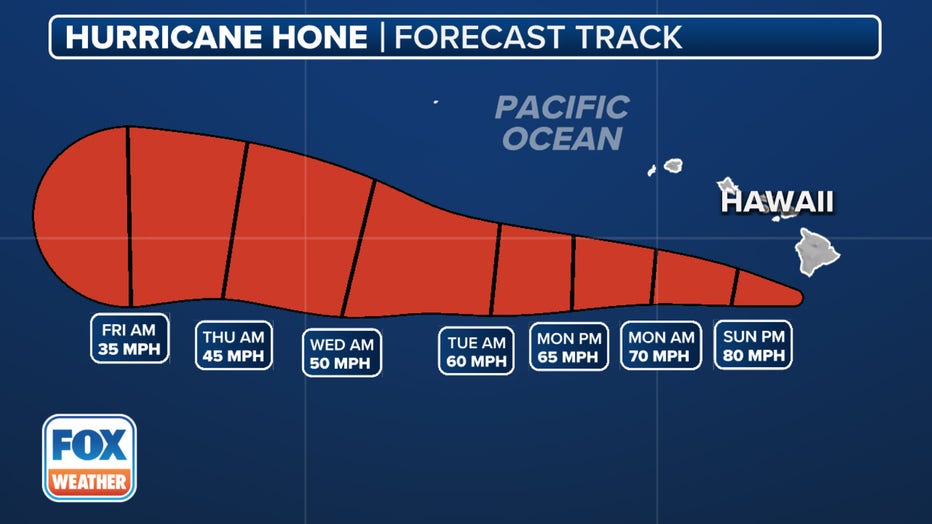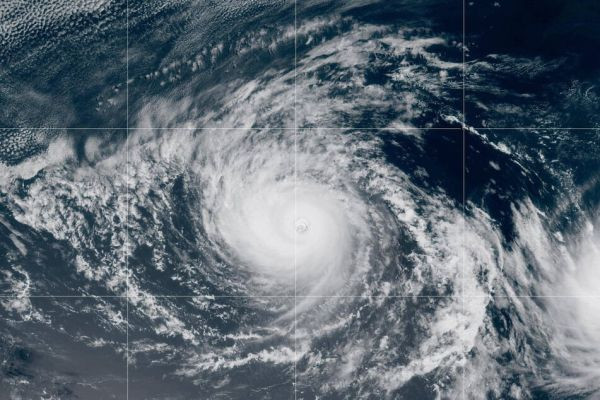Hurricane Hone, a powerful and destructive tropical cyclone, recently made landfall in Hawaii, bringing with it torrential rains, fierce winds, and significant disruption to daily life. As the latest in a series of intense weather events to hit the Pacific Islands, Hone has left a lasting impact on the region, highlighting the growing challenges posed by climate change and the increasing frequency of severe weather patterns. This article takes an in-depth look at Hurricane Hone, exploring its development, the effects on Hawaii, and the broader implications for the future.
1. The Formation and Path of Hurricane Hone
Hurricane Hone began as a tropical depression in the central Pacific Ocean, gradually gaining strength as it moved westward toward the Hawaiian Islands. Meteorologists closely monitored the storm as it intensified, eventually reaching hurricane status. The warm ocean waters and favorable atmospheric conditions contributed to Hone's rapid development, transforming it into a Category 3 hurricane with sustained winds of over 120 mph.
As the hurricane approached Hawaii, forecasters predicted significant impacts, including heavy rainfall, storm surges, and high winds. The state government and emergency services quickly mobilized, issuing warnings and advising residents to prepare for the worst. The storm's path was carefully tracked, with updates provided regularly to ensure that the public was informed and ready to take necessary precautions.
Hurricane Hone made landfall on the Big Island, bringing with it the expected severe weather conditions. The hurricane then moved across the island chain, affecting Maui, Oahu, and Kauai. Each of these islands experienced varying degrees of impact, with some areas facing more severe consequences than others. The storm eventually weakened as it moved further west, but not before leaving a trail of destruction in its wake.
2. The Immediate Impact: Heavy Rain and Strong Winds
One of the most immediate and visible effects of Hurricane Hone was the heavy rainfall that inundated the Hawaiian Islands. The storm brought record levels of precipitation, leading to widespread flooding in both urban and rural areas. Rivers and streams overflowed, and flash floods became a major concern, particularly in low-lying regions. In some areas, rainfall totals exceeded 20 inches, overwhelming drainage systems and causing significant water damage to homes, businesses, and infrastructure.
The strong winds accompanying the hurricane were equally destructive. Gusts of up to 140 mph were reported in some areas, toppling trees, downing power lines, and damaging buildings. Coastal regions faced the additional threat of storm surges, which caused erosion, flooding, and damage to beachfront properties. The combination of wind and water made Hurricane Hone one of the most powerful storms to hit Hawaii in recent years.
Power outages became widespread as the hurricane's winds knocked out electrical grids across the islands. In some cases, the restoration of power took several days, leaving residents and businesses in the dark and without access to essential services. Communication networks were also disrupted, complicating rescue and recovery efforts and making it difficult for people to stay informed about the ongoing situation.
3. The Human Cost: Evacuations and Emergency Response
As Hurricane Hone bore down on Hawaii, the state's emergency management agencies took swift action to protect residents and visitors. Mandatory evacuations were ordered in some of the most vulnerable areas, particularly along the coastlines and in flood-prone regions. Shelters were set up across the islands to accommodate those displaced by the storm, providing food, water, and medical care to those in need.
Emergency services were stretched thin as they responded to calls for help from across the islands. First responders, including police, fire, and medical personnel, worked around the clock to assist those affected by the hurricane. In many cases, their efforts were hampered by the dangerous conditions, including flooded roads, downed trees, and debris that made travel difficult and hazardous.
Tragically, Hurricane Hone resulted in several fatalities and numerous injuries. The exact toll is still being assessed, but early reports indicate that the storm claimed the lives of at least a dozen people, with many more injured by falling debris, car accidents, and other storm-related incidents. The loss of life underscored the severity of the hurricane and the challenges faced by those trying to survive and respond to the disaster.

4. Economic Impact: Damage to Infrastructure and Agriculture
In addition to the human cost, Hurricane Hone inflicted significant economic damage on Hawaii. The storm's powerful winds and heavy rains caused widespread destruction of infrastructure, including roads, bridges, and buildings. The cost of repairing and rebuilding this infrastructure is expected to run into the hundreds of millions of dollars, straining the state's resources and potentially delaying recovery efforts.
One of the most heavily affected sectors was agriculture, a vital part of Hawaii's economy. The storm's winds destroyed crops, particularly in the coffee and macadamia nut industries, which are major exports for the state. Farmers reported devastating losses, with some estimating that it could take years to fully recover from the damage. The impact on agriculture also has broader implications for food security in Hawaii, as the state relies heavily on locally grown produce to supplement imports.
Tourism, another cornerstone of Hawaii's economy, was also disrupted by the hurricane. Many tourists were forced to cancel or cut short their trips due to the storm, and several hotels and resorts reported damage from flooding and high winds. The long-term impact on tourism is still uncertain, but the hurricane has undoubtedly caused a short-term decline in visitors, further straining the local economy.
5. Environmental Consequences: Erosion and Habitat Destruction
Beyond the immediate human and economic impacts, Hurricane Hone also had significant environmental consequences. The heavy rainfall and storm surges led to severe erosion along Hawaii's coastlines, washing away beaches and damaging coral reefs. The loss of these natural barriers could make the islands more vulnerable to future storms and rising sea levels, compounding the challenges posed by climate change.
Inland, the storm caused landslides and mudslides in mountainous areas, stripping away vegetation and destabilizing the landscape. These events not only damaged ecosystems but also posed a threat to human settlements, as landslides buried roads and homes. The destruction of forests and other habitats also had a severe impact on Hawaii's unique wildlife, some of which is found nowhere else on Earth. Conservationists are concerned that the storm could push several endangered species closer to extinction, further highlighting the fragility of the islands' ecosystems.
The environmental damage caused by Hurricane Hone underscores the need for stronger conservation efforts and more sustainable land management practices. As the frequency and intensity of storms in the Pacific increase, Hawaii and other island nations will need to adapt to these new realities to protect both their natural environments and the people who depend on them.
6. The Role of Climate Change: A Growing Threat
Hurricane Hone is part of a broader pattern of increasingly severe weather events linked to climate change. Scientists have warned that rising global temperatures are leading to more frequent and intense hurricanes, particularly in regions like the Pacific where ocean temperatures are rising. These warmer waters provide the energy that fuels hurricanes, making them more powerful and more likely to cause significant damage when they make landfall.
The impact of climate change on hurricanes is not limited to their intensity. Rising sea levels, driven by the melting of polar ice caps, are also exacerbating the effects of storm surges, leading to more widespread coastal flooding. In Hawaii, where much of the population lives near the coast, this presents a significant risk, as storms like Hone can cause devastating damage to homes, businesses, and critical infrastructure.
The increasing threat of climate-related disasters is forcing Hawaii and other vulnerable regions to rethink their approach to disaster preparedness and response. There is a growing recognition that traditional methods may no longer be sufficient in the face of more powerful and unpredictable storms. Investments in infrastructure that can withstand these conditions, as well as improved early warning systems and evacuation plans, will be essential to minimizing the impact of future hurricanes.
7. Lessons Learned and the Path Forward
Hurricane Hone has left a lasting impact on Hawaii, but it has also provided valuable lessons for the future. The storm highlighted the importance of preparedness, both at the individual and community levels. While many residents heeded the warnings and took appropriate action, the scale of the disaster demonstrated that more needs to be done to ensure that everyone is ready for such events.
One of the key takeaways from Hurricane Hone is the need for stronger infrastructure that can withstand the effects of powerful storms. This includes not only physical structures like buildings and roads but also the systems that support emergency response and recovery efforts. Investments in resilient infrastructure will be crucial to protecting lives and property in the face of future hurricanes.
Another important lesson is the need for greater public awareness and education about the risks posed by hurricanes and other climate-related disasters. While Hawaii has a long history of dealing with tropical storms, the increasing severity of these events means that the public must be more informed and better prepared than ever before. This includes understanding the importance of evacuation orders, knowing where to find shelter, and having a plan in place for when disaster strikes.
Finally, Hurricane Hone serves as a stark reminder of the urgent need to address climate change. While individual storms cannot be directly attributed to global warming, the broader trend of more intense and frequent hurricanes is closely linked to the changing climate. Reducing greenhouse gas emissions and implementing policies to mitigate the impact of climate change are essential steps in preventing future disasters of this magnitude.
8. Conclusion: A Storm to Remember
Hurricane Hone will be remembered as one of the most powerful and destructive storms to hit Hawaii in recent memory. Its impact on the islands has been profound, affecting everything from the economy and environment to the lives of the people who call Hawaii home. As the state begins the long process of recovery, the lessons learned from this storm will be crucial in preparing for the challenges that lie ahead.
While the immediate focus is on rebuilding and helping those affected by the hurricane, the broader implications of Hone cannot be ignored. As climate change continues to shape the world we live in, hurricanes like Hone are likely to



